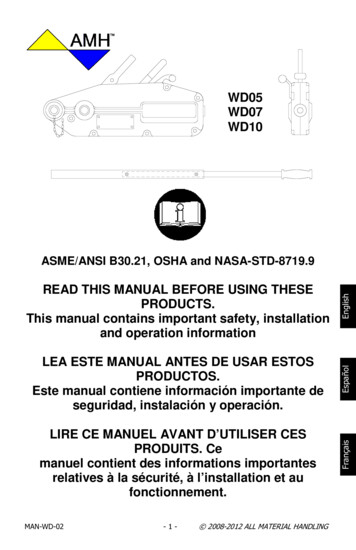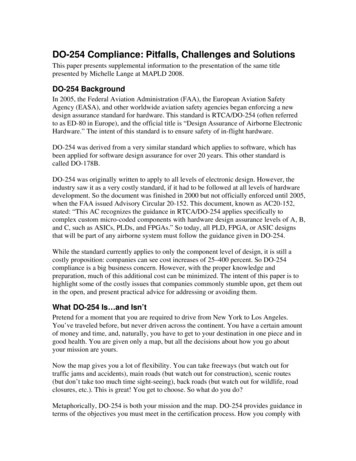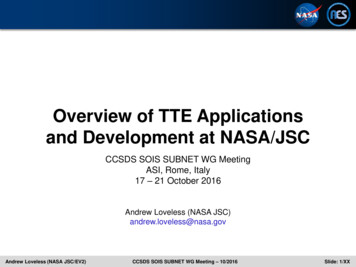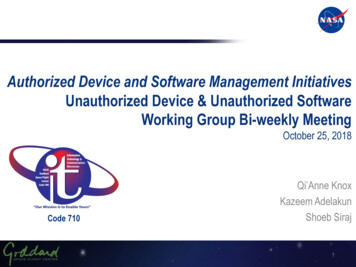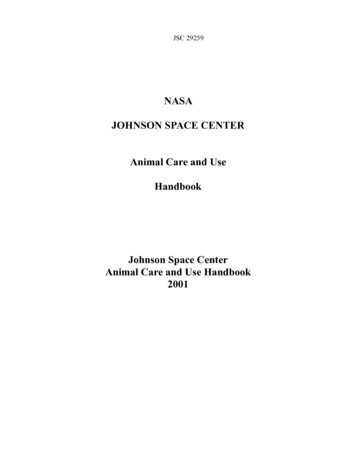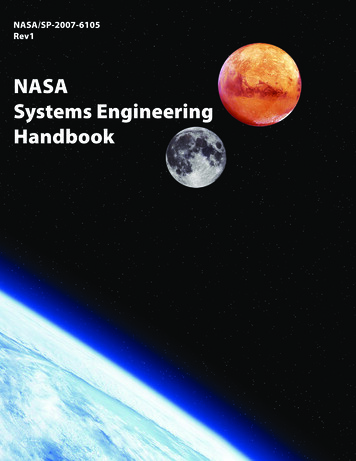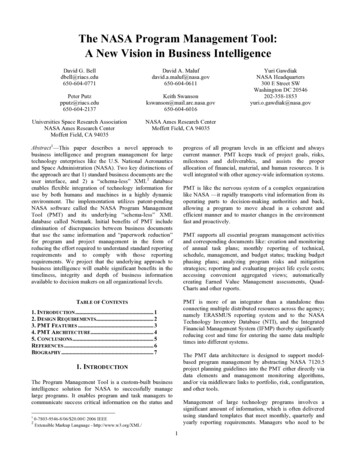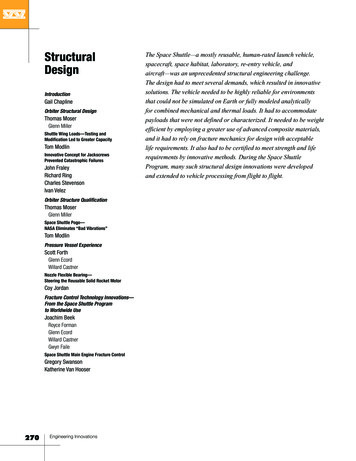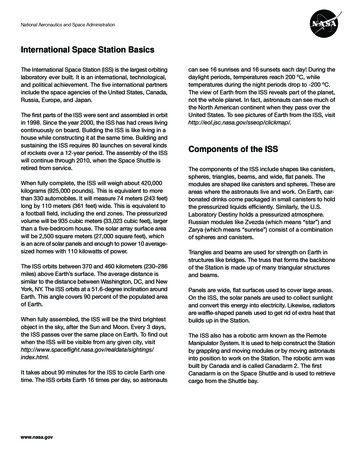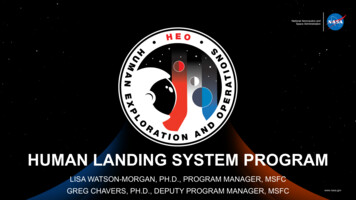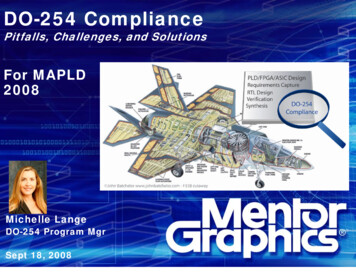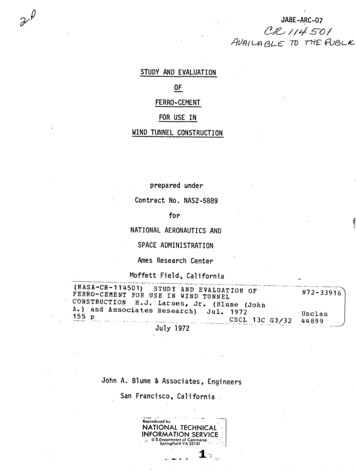
Transcription
JABE-ARC-07GVLU /?/V/7LS)STUDY AND EVALUATIONOFFERRO-CEMENTFOR USE INWIND TUNNEL CONSTRUCTIONprepared underContract No. NAS2-5889forNATIONAL AERONAUTICS ANDSPACE ADMINISTRATIONAmes Research CenterMoffett Field, California,.STUDY AND EVALUATION OF(NASA-CR-114501)FERRO-CEMENT FOR USE IN WIND TUNNEL(Blume (JohnH.J. Larsen, Jr.CONSTRUCTION1972Jul.A.) and Associates Research)CSCL 13C G3/32155 pN72-33916Unclas44899.July 1972John A. Blume & Associates, EngineersSan Francisco, CaliforniaReproduced byNATIONAL TECHNICALINFORMATION SERVICEU S.Department of CommerceSpringfield VA 22151
FOREWARDThe successful completion of a state-of-the-art survey such as theone reported herein is dependent on the cooperation of a number ofindividuals.Professor R. B. Williamson, University of California,Berkeley was especially helpful as was Professor S. P. Shah, Universityof Illinois at Chicago Circle.such as M. E.The assistance of those in industryIrons of Fibersteel Corporation and D. A. Seymour, NavalArchitect is also appreciated.Professor W. J. Venuti, CaliforniaState University, San Jose helped develop the laboratory test criteriaand supervised the testing of all samples.The work in the Blume office was conducted under the general supervision of Roland L. Sharpe, Principal-in-charge, and James E. Boyd,Project Manager.Henry J. LarsenrJr.-was the principal investigatorresponsible for compilation, review and evaluation of the data aswell as planning and conduct of the laboratory testing program.JOHN A. BLUME & ASSOCIATES.ENGINEERS
JABE-ARC-07STUDY AND EVALUATIONOFFERRO-CEMENTFOR USE INWIND TUNNEL CONSTRUCTIONCONTENTSPageFOREWARD iINTRODUCTION ------------------------------------- ---THE NATURE OF FERRO-CEMENT -------------------------------- 4A.General Properties ------------------------------------ 4B.History ----------------------------------------C.Uses of Ferro-cement ---------------------------------- 75THE STATE-OF-THE-ART IN FERRO-CEMENT ------------------- 9A.B.C.Strength Properties -----------------------------------91.Compressive Strength ------------------------------102.Tensile Strength ----------------------------------103.Flexural Strength ---------------------------------144.Shear Strength ------------------------------------165.Modulus of Elasticity -----------------------------166.Fatigue Resistance --------------------------------187.Impact Resistance ---------------------------------20Material Constituents ---------------------------------231.Mortar ement ce Characteristics ---------------------------281.Surface Characteristics ---------------------------283ii-JOHN A. BLUME & ASSOCIATES, ENGINEERS
JABE-ARC-07CONTENTS (continued)Page2.Corrosion Resistance ----------------------------303.4.Vibration and Acoustical Characteristics ---------- 33Fire Resistance ty -------------------------------------6.Dimensional Stability -----------------------------35Maintenance urrent Construction Methods --------------------------38FERRO-CEMENT TESTING PROGRAM ----------------------------42A. Description of Tests ----------------------------------421.2.3.4.Test Samples -------------------------------------43Static Load Tests ---------------------------------45Flexural Fatigue Tests ----------------------------46Flexural Vibration Tests --------------------------465.B.V.Air Abrasion Tests --------------------------------47Presentation and Discussion of Results ---------------- 471.Static Load Tests ---------------------------------472.3.Flexural Fatigue Tests ---------------------------50Flexural Vibration Tests --------------------------514.Air Abrasion Tests --------------------------------54FERRO-CEMENT FOR WIND TUNNEL CONSTRUCTION --------------55A. Evaluation of Ferro-cement Characteristics ------ 55B.C.Typical Performance Requirements ----------------------60A Preliminary Construction Scheme --------------------- 61VI.COST STUDY OF FERRO-CEMENT FOR WIND TUNNEL CONSTRUCTION --- 64VII.SUMMARY OF FINDINGS ---------------------------------------684-iv-JOHN A. BLUME &ASSOCIATES, ENGINEERS
JABE-ARC-07CONTENTS (continued)PageA.State-of-the-Art Study --------------------------------68B.70Test Program ------------------------------------------C.Cost I.CONCLUSIONS AND RECOMMENDATIONS ---------------------------73IX.REFERENCES AND BIBLIOGRAPHY nary Criteria for Design of Ferro-cement ShellsBReview of Feasibility of Using Ferro-cement for ProposedNASA Wind Tunnel Drive SectionCLaboratory Report on Structural Investigation of Ferrocement SpecimensDRevision of Design Study of Power Section for ProposedV/STOL Wind TunnelTABLEIFerro-cement Test Sample Data -------------------------44IISummary of Static Test Results ------------------------48IIIFatigue Test Results ----------------------------------50IVVibration Test Results --------------------------------52.VProposed Ferro-cement Design Stresses ----------------- 56VIComparative Ferro-cement and Steel Load Capacities ----58VIIFerro-cement Unit Costs for Wind Tunnel Drive Section - 66D-1Revision of Design Study of Power Section forProposed V/STOL Wind Tunnel ---------------------------D-2Following PageFIGURE1Typical Ferro-cement Sections ------------------------- 42Typical Tensile Load Elongation Behavior -------------- 10*vJOHN A. BLUME &ASSOCIATES, ENGINEERS
JABE-ARC-07CONTENTS (continued)Following Page3Working Stages of Ferro-cement ------------------------114Tensile Stress at First Crack vs. Volume ofReinforcement ---------------------------------------- 125Tensile Cracking Behavior vs. Specific Surfaceof -126Hypothetical Ferro-cement Design Curves Based onCrack Width e Load of Composite vs. Ultimate Capacity ofReinforcement ---------------------------------------- 138Typical Flexural Load-Deflection Behavior ------------- 149Flexural Stress at First Crack vs. Specific Surfaceof Reinforcement --------------------------------------1410Ultimate Shear Stress vs. Volume of Reinforcement ----- 1611Composite Modulus of Elasticity in Tension ------------ 1712Ferro-cement Fatigue Tests ---------------------------- 1813Effect of Specific Surface and Tensile Strength ofReinforcement on Impact Damage ------------------------201416Freeze-Thaw Cycle Tests -------------------------------32Sound Transmission Loss for Dense Concrete (Ferrocement) vs. Steel t Creep Tests ------------------------------3617Test Sample Fabrication Photographs ------------------- 4418Ferro-cement Testing Photographs ---------------------- 4519Static Flexure Test Sample #26 ------------------------4820Static Flexure Test Sample #3 -------------------------4821Typical Vibration Test Records ------------------------531522Longitudinal Section Through Proposed Wind TunnelDrive Section rse Section Through Proposed Wind TunnelDrive Section al Isometric View of Shroud and Support Framing -- 6225Nacelle Mold st Segment Connections --------------------------- 63-vi-JOHN A. BLUME & ASSOCIATES, ENGINEERS
JABE-ARC-07CONTENTS (continued)Following Page27A-1Precast Ferro-cement Shroud Segment-63Typical Pressure Distribution for Large-ScaleSubsonic Wind TunnelA-2. .-vii-JOHN A. BLUME &ASSOCIATES, ENGINEERS
I.INTRODUCTIONThis report presents the results of an investigation into the structural suitability and cost effectiveness of ferro-cement for largesubsonic wind tunnel structures.It was conducted in accordance withchange Item No. 7, dated January 20, 1972, of contract NAS2-5889,dated March 31, 1970.This investigation was carried out in thefollowing four main categories:(1)A state-of-the-art survey intothe uses, properties, and costs of ferro-cement; (2) An evaluationof those ferro-cement properties critical to construction of large,subsonic wind tunnels, which have not been adequately established todate; (3) A laboratory testing program to determine preliminary valuesfor those properties; and (4) A study to establish cost factors forferro-cement as related to a preliminary construction scheme for anacelle and shroud unit of the type and configuration presented inthe March 22, 1971, John A. Blume & Associates, Engineers report,"Conceptual Design Study of Power Section for a Proposed V/STOL WindTunnel." These cost data were then used to revise and update the costestimate in that report pertaining to the use of ferro-cement.During the course of this investigation published data on ferro-cementresearch were reviewed and evaluated and recognized experts in ferrocement research, construction, and economics were consulted.Theseconsultants included university faculty members and governmentpersonnel involved in basic research in ferro-cement and also privatefirms currently engaged in commercial design and construction of ferrocement marine craft and other structures.Ferro-cement specimens forthe laboratory testing program were fabricated at a commercial marineconstruction yard specializing in ferro-cement boat construction.Thespecimens were tested at a university testing laboratory experiencedin static and fatigue testing of construction materials.8-1JOHN A. BLUME &ASSOCIATES.ENGINEERS
The most significant findings reported herein, relative to wind tunnelconstruction, are the following:1.Ferro-cement is a relatively new construction material that consists basically of a thin-shell of Portland cement mortar heavilyreinforced with light gage steel wire mesh.Significant improve-ment in both cracking strength of mortar and the extent of crackingresult from wide dispersal of reinforcement in the cross section.Ferro-cement capacity to resist all types of loads except compression is dependent on the volume and surface area of the reinforcement.2.Surface smoothness and overall durability of ferro-cement is highalthough protective coatings may be required in corrosive environments.Resistance to impact loads is relatively low.Repair ofdamaged areas, however, is relatively simple.3.Estimates based on the properties of dense concrete indicate thatthe acoustical attenuation properties of a ferro-cement shell aresuperior to an equivalent steel shell for certain sound frequencyranges.4.A limited ferro-cement testing program yielded the following resultsbased on the samples tested:(a) Resistance to fatigue loadingnear the level of cracking stress is high; (b) Resistance to surfaceabrasion from high velocity air flow is high; and (c) Naturalvibration frequencies can be predicted from basic material propertiesof ferro-cement.5.In terms of structural and economic feasibility, ferro-cement ismost applicable to wind tunnel structures in areas of curved, thinshell construction with relatively low design loading.- 2 JOHN A. BLUME&ASSOCIATES, ENGINEERS
6.For many structures where ferro-cement strength properties areconsistent with design requirements, significant cost advantagescan be expected relative to structural steel.Maximum economy canbe obtained by reducing the large labor costs typical of ferrocement construction through use of automated production methods.7.There is a limited amount of ferro-cement test data available atpresent, relative to other building materials such as steel orconcrete.Large-scale structural applications should, therefore,be based on specific test programs to establish an optimum design.Principal areas for further work include more comprehensive fatiguetesting, reinforcement and mix design studies, durability studies,and full-scale load testing.1.- 3JOHN A. BLUME&ASSOCIATES, ENGINEERS
II.THENATUREOFFERRO-CEMENTThe ferro-cement concept is as old as that of reinforced concrete, butits use as a structural material has received widespread attention onlyin the last several decades.Ferro-cement is given a brief descriptionand then the history of its development and current and proposed applications are summarized in the following text.A.GENERAL PROPERTIESFerro-cement basically consists of a thin-shell of Portland cementmortar heavily reinforced with steel wire.The reinforcement generallyTypicalconsists of several layers of light gage steel wire mesh.shell thicknesses are from 3/8 inch to 1-1/2 inches.Sometimes steelreinforcing bars are sandwiched between the layers of wire mesh.Figure 1 shows two common types of ferro-cement reinforcing.Sectionla of Figure 1 shows a network of steel reinforcing bars overlain withlayers of wire mesh that is impregnated with mortar.The use of rein-forcing bars with wire mesh adds to the strength of the material andalso provides a means of establishing the structural shape.Section lbof Figure 1 is reinforced only with wire mesh and the required shape isobtained through external means such as casting molds.Because of theclose spacing of reinforcement evident in Figure 1, care has to betaken in placement of mortar.The material constituents of ferro-cement and those of more commonlyrecognized reinforced concrete are very similar, although the proportions of the materials used in ferro-cement give it several differentand unique properties.The behavior of ferro-cement during strain andcracking demonstrates a synergistic effect.Because the steel reinforcing4iJOHN A. BLUME&ASSOCIATES.ENGINEERS
57EEL REG5AR'.W/IRE MEfHJEC TI ONV/RE MESH). -*p.or.- Dg ' .w'.*.IBl0,, eSB.,*A*@ 9 *.(-/.**3*.**Se CTI ONcJFIURII - TYP/CAL. -12FRRO-CE41ENT7 SJCT/O/0J"JOHN A. BLUME & ASSOCIATES.ENGINEERS
is very evenly dispersed through the cross section, formation of crac
testing, reinforcement and mix design studies, durability studies, and full-scale load testing. 1. - 3-JOHN A. BLUME & ASSOCIATES, ENGINEERS. II. THE NATURE OF FERRO-CEMENT The ferro-cement concept is as old as that of reinforced concrete, but its use as a structural material has received widespread attention only in the last several decades. Ferro-cement is given a brief description and

